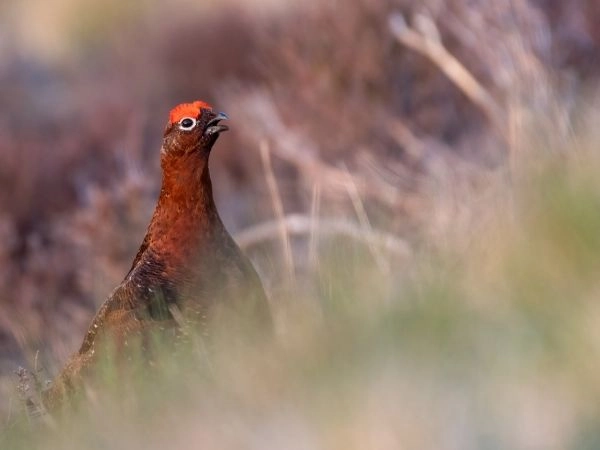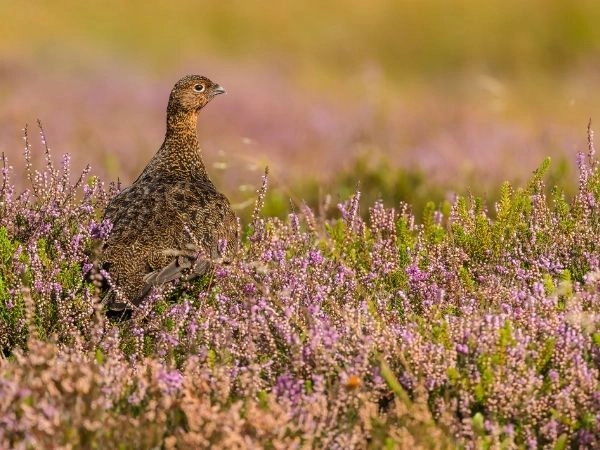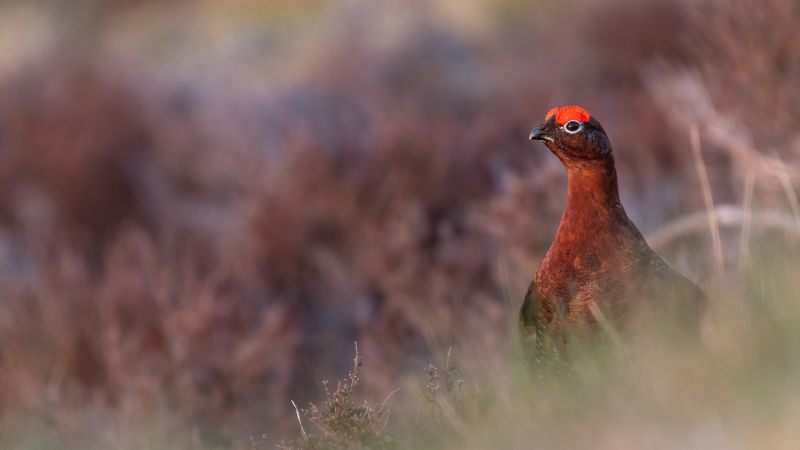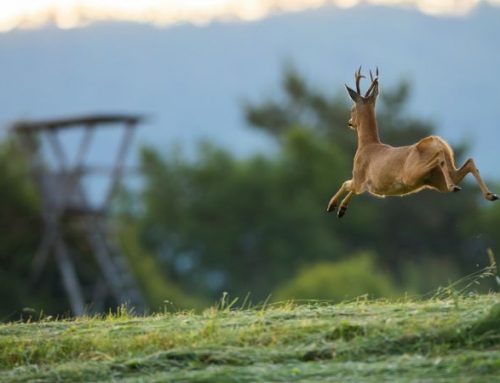There is a moment, every year, when the British moorland awakens.
It’s August 12th—the Glorious Twelfth—the official opening of the Red Grouse season, the queen of the moorland birds, an animal that for over a century has fueled myths, fortunes and debates.
Once, it was the most eagerly anticipated day for the English and Scottish aristocracy: carriages and Rolls Royces climbed the Highland valleys, the staff polished the Purdey guns, and gentlemen in heather-coloured tweed prepared for the year’s first drive.
Today, that centuries-old ritual survives, but it has changed.
Behind the timeless allure of the kings’ hunt lies an increasingly fragile balance, shaped by ecological decline, political controversy, environmental pressures and economic uncertainty.
And the question that drifts across the moors, in the silence broken only by wind and dogs, is simple: how long can it last?
The allure of a British icon
The Red Grouse (Lagopus lagopus scotica) is an endemic species—unique in the world.
It lives only here: on the moorlands of Scotland and northern England, where heather rules the landscape and the wind never stops.
It is small, fast, striking: rust-red feathers, intense eyes, and an unpredictable flight that makes it the most challenging airborne game in Europe.
No animal embodies the British spirit more closely, because grouse shooting is not just hunting—it is culture, language, social hierarchy, and rural aesthetics.

It is the hunt of Kings, Dukes and Lords—but also of the gamekeeper, the beater, and the trained pointing dog reading the wind.
A microcosm where every role—from the estate owner to the young boy carrying cartridges—holds a precise place in the ritual.
“A day on the grouse,” wrote a Times journalist in 1923, “is an orchestra in which even silence has its own music.”
But today, that orchestra plays more softly.
An economy built on the moor
To understand the weight of grouse shooting, just look at the numbers:
-
Grouse moors—moorland estates managed for shooting—cover around 1.5 million hectares across Scotland and northern England.
-
They generate hundreds of seasonal jobs—gamekeepers, beaters, cooks, guides, lodge and hotel staff—with an estimated economic impact of over £350 million per year.
-
A single organised shooting day can cost up to £15,000 for a team of eight guns, including accommodation, dogs, logistics and high-end catering.
But as estate managers now say, “what was once a luxury has become a financial risk.”
The decline: numbers and reality today
This year—2025—will not be remembered as a great season. In fact, many moors have cancelled or heavily reduced shooting.
Why? Many reasons, all intertwined.
According to the Game & Wildlife Conservation Trust (GWCT), the density of breeding pairs in Scotland has fallen 34% compared to 2024.
The average number of young per adult, although slightly improved (1.3 in 2025 vs 0.6 last year), remains too low to allow sustainable shooting days.
In parts of the central Highlands, gamekeepers have suspended the season entirely to allow natural recovery.
England fares little better.
The Yorkshire Dales and North Pennines have recorded densities halved compared to the best years of the last decade.
The Southern Dales have held up only partially, but even there drives are rare and highly selective.
“This year,” a moor manager in Perthshire told Field & Stream UK, “we preferred to give up twenty shooting days rather than compromise the next decade.”
The causes: between nature and man
-
Climate – increasingly cold and wet springs have devastated broods. Torrential May and June rain reduced chick survival, as they feed on insects in their first days. Without insects, they die.
-
Parasites – the notorious Heather Beetle has destroyed vast stretches of heather. Result: less habitat, less food, fewer nests. Without heather, grouse cannot survive.
-
Management policies – since 2024, Scotland has introduced a licensing system for grouse estates under the Wildlife Management and Muirburn Act. Each estate must prove sustainable and transparent land management—a reform born to tackle abuses, especially misuse of controlled burning (muirburn) and suspected illegal raptor killings.

- Many estates, however, claim that bureaucracy and legal uncertainty are discouraging investment and slowing active management.
“We’re not criminals,” a Scottish gamekeeper told The Telegraph. “We are guardians of the land. But they treat us like suspects.” - Social change – hunting in Britain is under media and political scrutiny. Environmental groups and progressive parties call for stricter restrictions, often supported by urban public opinion.
The image of a tweed-clad shooter in the Highland mist no longer evokes the romantic ideal of the past. Today, many see it as a symbol of privilege and inequality.
Anecdotes of glory and power
Still, the myth of the grouse remains timeless.
In 1892, King Edward VII opened the season at Balmoral with 2,000 grouse in a single day, shooting alongside the Prince of Wales and a young Winston Churchill.
Reports tell of 200 beaters, 40 dogs, and a private train carrying the game to London, where it was served that very evening in the gentlemen’s clubs of Pall Mall.
In the 1930s, the English aristocracy turned the moorland into a salon.
Scottish lodges hosted writers, industrialists, politicians: grouse shooting was status and society.
Then came war, recession, social change.
Yet still today, for those who cherish tradition, a day on the moors remains an almost mystical experience.
“When grouse take off,” wrote author John MacNab, “it is not flight—it is an explosion of life. It’s the moment you understand why you are there.”
Between aristocracy and modernity: the new face of the estates
Today, many estates have had to reinvent themselves.
Owners—often old families but increasingly international investors—are diversifying: nature tourism, birdwatching, trekking, salmon fishing.
Some offer “shooting light”: days with few birds and an emphasis on experience rather than numbers.
A form of cultural survival.
Fewer shots, more storytelling. Fewer trophies, more emotion.
Yet those who live this world know: without true managed shooting, the moors would die.
Heather would grow unchecked, spontaneous fires would increase, and many species—from skylark to mountain hare—would disappear with it.
Moor management, even when tied to shooting, is a form of active conservation.
As the British Association for Shooting and Conservation (BASC) often repeats:
“No management, no moor. No moor, no grouse. No grouse, no life.”
A nation divided between passion and ideology
The debate is fierce.
On one side, those who defend hunting as an economic and environmental pillar.
On the other, those who see it as a relic of the past, an unfair privilege.
In 2025, while data shows widespread stock decline, political forces debate further restrictions.
In Scotland, Parliament is considering stricter limits on muirburn and a review of licensing criteria.
In England, environmental groups push for direct government supervision of moors and a “transition towards non-lethal land-use models”.
The result? Total uncertainty.
Estates hesitate to invest. Tourist operators scale back. Gamekeepers—many with family roots stretching generations deep—feel abandoned.
“It’s as if they want to take away our soul,” said a warden from Inverness. “Moorland without shooting is just grass and silence.”
The uncomfortable truth: after the season
Speaking of “grouse decline” also means confronting an uncomfortable truth: this hunt is not just romanticism—it is a business, and like any business, depends on margin.
When stocks fall, costs stay.

Running a moor costs between £100,000 and £250,000 per year.
Without income from shooting days, many estates cannot survive.
Some are being sold, others are closing, still others are bought by ecological funds or NGOs turning moorlands into rewilding reserves—eliminating all hunting.
A profound shift that could erase, within a generation, one of the most layered and ancient cultural ecosystems in Europe.
An uncertain future: between hope and decline
There are, however, signs of resilience.
The improved young-to-adult ratio in 2025 suggests that grouse populations could recover if supported by proper management and favourable seasons.
Many moors are investing in scientific research, drone monitoring, ethical predator control and heather regeneration.
People speak of “eco-driven shooting”: sustainable hunting, transparent, with precise limits and full traceability.
It’s the direction many—even among the most traditional—consider inevitable.
A new ethic to preserve an ancient passion.
Returning to meaning
Walking a Scottish moor today is an experience of contrasts.
The wind cuts the skin, the ground is wet, the hills appear empty.
Yet life remains: the dog on point, the sudden beat of wings, the echo of a shot rolling through the valleys.
But the difference lies in the gaze.
Today’s hunters—the true, conscious ones—no longer seek records, but connection.
Not quantity, but purpose.
In a world that rushes, grouse hunting remains a lesson in slowness and attention.
It is no longer just “the hunt of kings”, but the hunt of those who know how to listen to the land.
A story to protect
“If the grouse disappear,” wrote Scottish author Finlay J. MacDonald, “it won’t be the end of hunting—but the end of a way of being.”
And perhaps he was right.
Today, on moors where once echoed the fine shots of the Dukes of Hamilton or Balmoral, a different silence reigns.
But it is not an empty silence.
It is a silence that asks for balance, that demands respect, that invites us to rethink hunting as an act of care and responsibility.
Because the true nobility of grouse shooting has never been found in titles, London clubs or sepia photographs.
It has always been in the moorland itself—in its colours, its wind, its silences.
And if the future of the kings’ hunt must change, then let it change this way:
less spectacle, more truth; fewer cartridges, more understanding.
Because as long as someone is willing to rise before dawn to walk among heather and northern wind, the voice of the grouse will not fall silent.





